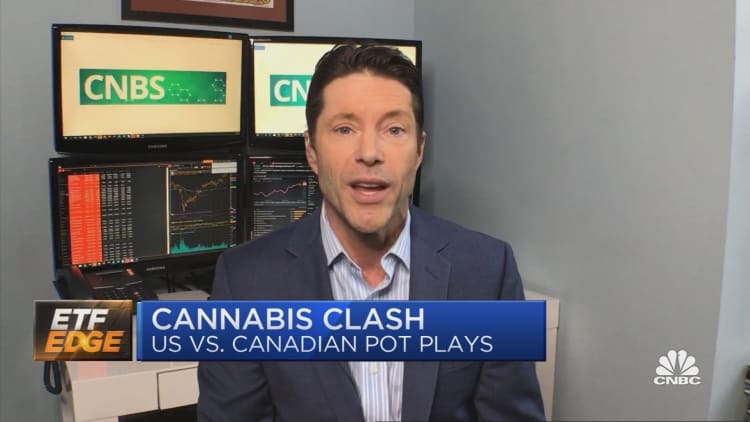
The cannabis market is having a bit of a heyday.
Cannabis stocks as a whole have been on the rise since the U.S. election, with U.S. names such as Trulieve, TerrAscend and Green Thumb Industries climbing alongside Canadian heavyweights including Canopy Growth, Aphria and Village Farms.
But there's an important distinction to be made between U.S. and Canadian pot plays, Tim Seymour, founder and chief investment officer of Seymour Asset Management and the portfolio manager of the Amplify Seymour Cannabis ETF (CNBS), told CNBC's "ETF Edge" this week.
U.S. names have enjoyed healthy gains in 2020, with Trulieve, TerrAscend and Green Thumb all up triple digits. And while the group's moves around the presidential election were "solid, ... overall, cannabis stock trading was confusing at best," Seymour said in a Wednesday interview.
Though the U.S. pot plays rallied heading into the election, Canadian cannabis stocks managed to outperform afterwards. That set up a counterintuitive dynamic: If the election served to highlight the U.S. opportunity, with five states legalizing some form of cannabis use, why were the Canadian plays rallying?
In some ways, it's a function of how the market is structured, Seymour said.
When Canada federally legalized cannabis use in 2018, Canadian pot stocks became "the conduits in which a lot of institutions could access the cannabis market, even if the Canadian [limited partnership]s were not necessarily sitting in the middle of the biggest and most important market in this new high-growth sector," he said.
Now operating legally, those companies were able to list on U.S. exchanges, making the likes of Canopy Growth and Aphria easily accessible to U.S. investors. Shares of U.S.-based players dealing directly with cannabis, however, are listed on Canadian exchanges, and are only bought and sold in the U.S. via the over-the-counter markets.
Additionally, while over-the-counter stocks in many cases "have significant liquidity and are as efficient to trade" as stocks on major exchanges, some institutions and ETFs are limited from investing in that market.
"Picking the best stocks often is about understanding where capital is going," Seymour said. "Investing in cannabis is as much about understanding the fundamentals both bottom-up and top-down as it is really understanding fund flows and understanding the momentum in the market."
Much of that momentum has centered on Canadian colossus Canopy Growth, in which U.S. alcohol giant Constellation Brands has a major stake.
Though it is based in Ontario, Canopy has strong U.S. ties given its relationship with Modelo maker Constellation and its investments in stateside operators Acreage Holdings and TerrAscend, Seymour said.
It also has a "very strong" management team, hence its prominent place in CNBS's portfolio, said Seymour, who added that the key to running a cannabis ETF is active management.
"You want to be investing with someone who's certainly investing in the middle of the sector, is involved in the sector, is meeting with company management teams daily, but also understanding where we can get the best of the markets that we can invest in," Seymour said.
As of Friday, CNBS's top five holdings were GrowGeneration at more than 12.5%, Village Farms at over 12.5%, Canopy Growth at almost 11.5%, Aphria at nearly 11.5% and GW Pharmaceuticals at just under 10.5%. Innovative Industrial Properties, a medical cannabis-focused REIT, was No. 6 at just over 7%.
Not only does active management allow Seymour to look for "ancillary exposure" to the space with names such as Innovative Industrial Properties or hydroponics retailer GrowGeneration, but it allows him to capitalize on the industry's up-and-comers.
"There will be IPOs coming in the next three to six months that will give us more opportunities and we'll be there for them," he said. "Active management in cannabis is critical and I think our ability to really pick from the best of what's around the world is part of why you've seen this ... disparity between the performance of the different cannabis ETFs."
CNBS is up 38.5% year to date as of Friday's close. The ETFMG Alternative Harvest ETF (MJ), the largest cannabis ETF on the market by assets, is down nearly 8%. The AdvisorShares Pure Cannabis ETF (YOLO), the second largest, is up about 42.5%.
"Ultimately, our view is that we want to be investing in the stocks that we know have not only the best fundamentals, but the ones that have the most exposure to institutions who might be looking to invest in the sector," Seymour said.
That may mean you can only invest "in some of the Canadian names or the big listed U.S. names that are not plant-touching, but great ways to get exposure," he said. "The key is balance. The key is active management. This is an industry that will continue to evolve and an active strategy in a really exciting thematic strategy is, we think, the best way to manage your money."
Disclosures: Read all of Seymour's disclosures here.





